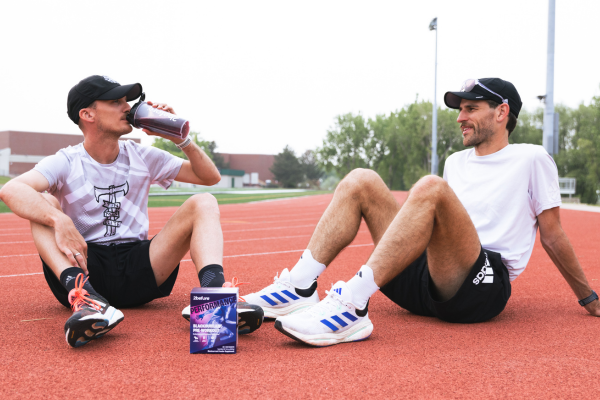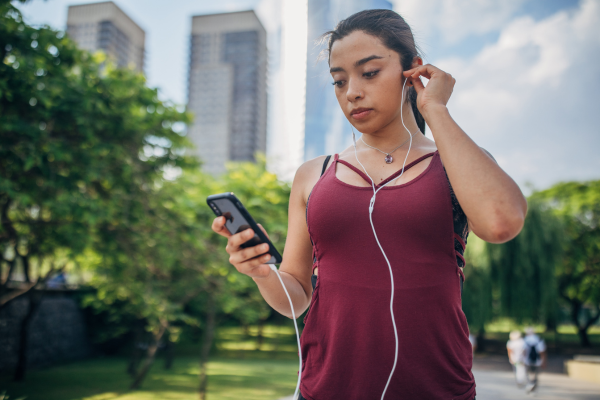Bounce Back Stronger: Your Ultimate Guide to Athlete Recovery
Solving the Recovery Puzzle
There’s a sign you've probably seen on many gym walls that goes something like "Eat. Sleep. Workout. Repeat."

True, it’s a pretty crude as plans go, but if you follow it, you won't go too far wrong, and after all, how many of us have any recovery plan?
As always, the devil is in the details.
Recovery is more than just resting; you need to actively put back what your exercise has taken out of you.
The good news is there are a lot of things you can do to make recovery happen faster and better.
The Power on Your Plate: Fueling Recovery Through Nutrition and Hydration
Let’s start with the obvious one - nutrition. Just like a high-performance engine needs the right fuel to run smoothly, your body needs the right nutrients to recover properly after a tough workout.
This is where proper nutrition and hydration come into play, we recommend a ratio of 3:1 carbohydrates to protein to help you refuel after a workout.
Carbohydrates: Replenishing Your Energy Stores: During exercise, your body uses glycogen (stored carbohydrates) for energy. Post-workout, you have to replenish these glycogen stores to make sure your body is restocked, so you can go out there again next time. Focus on complex carbohydrates like whole grains, fruits, and vegetables. These provide sustained energy and essential vitamins and minerals for overall well-being. (For a deeper dive into athletic nutrition strategies, check out our blog on optimizing athletic nutrition for performance!)
Protein: The Building Blocks of Repair: After exercise, your muscles experience microscopic tears. That sounds bad, but it’s normal, it’s the way muscle rebuilds itself to make it stronger, and to do that, it needs protein. Aim to consume 0.14-0.2 grams of protein per kilogram of body weight within an hour or so after a workout. A lot of athletes use supplements, and they’re an easy way to make sure you're getting enough protein, but lean meats, fish, eggs, and plant-based proteins like tofu and lentils are all excellent sources.
Don't Forget Hydration: Water is the foundation of life, and it's even more crucial for athletes - that sweat has to come from somewhere! Dehydration can hurt performance and slow down your recovery, so make sure you’re drinking enough to stay hydrated during the day, and even more before, during, and after workouts.
A Pre-Workout to Improve Recovery: (A shameless plug here for 2before). It might seem strange, but you can start your recovery before you exercise. Studies have shown blackcurrant powder can “facilitate recovery from exercise-induced oxidative stress” [3] and help with the “management of moderate exercise-induced oxidative stress and inflammation”. [4] In other words, taking blackcurrant powder before you work out can help you recover after working out.
By getting enough protein, carbohydrates, and sufficient hydration, you're providing your body with a good start on what it needs to rebuild, refuel, and bounce back stronger for your next training session.
Read our blog for a deep dive into nutrition for sports recovery.
Sleep: The Cornerstone of Recovery
While nutrition fuels your body, sleep is the architect that rebuilds it. Think oif it like this: time spent asleep equals time spent by your body doing essential repair and restoration.
Sleep: The Body's Repair Shop Sleep is when your body produces growth hormone, a key player in muscle repair and growth. It's also the time when your immune system strengthens, helping to fight off infections that can hinder recovery.
Just as important, sleep is crucial for mental health. It helps keep your brain working at its best and your emotions regulated, so you out there looking for places to do your next workout, not places to hide from it.
Sleep Hygiene for Athletes The usual rules apply here. To help maximize the benefits of sleep, establish a consistent sleep routine. Aim for 7-9 hours of quality sleep each night. Create a calming bedtime ritual, such as reading or taking a warm bath. Ensure your sleep environment is dark, quiet, and cool. Limit screen time before bed, as the blue light emitted by electronic devices can interfere with sleep.
See more in our blog Sleep & Performance: Why rest is the missing piece in your training regime.
Cool Down and Recover: The Power of Cold Therapy
Inflammation is a natural response to exercise, but excessive inflammation can hurt your ability to recover and perform. This is where cold therapy comes in. By constricting blood vessels, cold therapy helps to reduce inflammation, pain, and muscle soreness.
A quick sidenote for female athletes here, women tend to sweat less than men which can raise their core body temperature, this means they can especially benefit from using cooling recovery methods, such as cold-water immersion (CWI) due to their lower thermolytic capacities than males. [1]
Ice Baths: A Deep Dive into Recovery
Watching people take the “ice bucket challenge” got a lot of laughs, but turns out covering yourself in cold water is a great way to quicken up recovery. The cold shock reduces blood flow to the affected area, minimizing swelling and inflammation. Ice baths are particularly effective for treating muscle soreness and reducing lactic acid buildup.
Cold Showers: A Refreshing Recovery Boost
If you don't have access to an ice bath, a cold shower can be a refreshing alternative. While not as intense as an ice bath, cold showers still provide benefits by constricting blood vessels and reducing inflammation. Focus the cold water on sore muscles for targeted relief.
If you want to know all about ice and recovery see our blog on cold therapy for athletes.
Compression Therapy: Supporting Your Recovery
If you want to take it to the next level, compression garments or wraps can enhance the effects of cold therapy by helping to reduce swelling and improve blood circulation.
Heat Therapy: Soothe and Relax Your Muscles
While cold therapy is fantastic for reducing inflammation, heat therapy offers a different approach to recovery.
By increasing blood flow and relaxing muscles, heat can help alleviate soreness and tension.
Saunas: A Traditional Recovery Remedy
Saunas have been used for centuries to promote relaxation and well-being. The heat causes your blood vessels to dilate (open up), increasing blood flow to your muscles. This improved circulation delivers essential nutrients and oxygen to your tissues, aiding in repair and recovery (the anthocyanins in blackcurrants have been shown to deliver a similar effect [5]). Additionally, the heat can help relieve muscle tension and stiffness, making it an excellent choice for athletes dealing with soreness.
Hot Baths: A Relaxing Retreat
A warm bath is a classic remedy for tired muscles, and best of all, it doesn't feel like the hard work other recovery methods need! The buoyancy of the water reduces joint pressure, allowing your muscles to relax and release tension. The heat also improves circulation, similar to a sauna, helping to flush out metabolic waste products and promote healing. Adding Epsom salts to your bath can enhance the relaxing and muscle-soothing effects.
Remember, while heat therapy can be beneficial, it's essential to listen to your body.
For a complete guide to how heat can help recovery, see our blog on recovery with heat therapy for athletes.
Active Recovery: Moving Your Way to Recovery
While rest is essential, staying completely inactive after a tough workout isn't always the best approach, no matter how tired you feel. Active recovery involves low-intensity exercise that helps flush out waste products, improve circulation, and promote overall recovery.
And it doesn’t have to take long. Active recovery sessions as short as 6-10 minutes have revealed consistently positive effects on performance. [2] Additionally, if you're a female athlete these can be even more beneficial because women have a greater decrease in arterial blood pressure after exercise compared to males.[1]
Gentle Movement for Optimal Recovery
Activities like walking, swimming, or cycling at a leisurely pace are excellent options for active recovery. These are simple, low-impact exercises that increase blood flow to your muscles, delivering the good stuff oxygen and nutrients while removing waste products that build up during exercise. This enhanced circulation helps reduce muscle soreness and get you feeling better, faster.
Remember, the key to active recovery is to choose activities that are easy on your body. The goal is to keep your muscles moving without putting additional strain on them.
Stretching and Mobility: The Key to Flexibility
Flexibility and mobility are often overlooked aspects of recovery - when you’re young, it feels too easy, when you’re older, it feels too hard! - but they play a crucial role in preventing injuries and enhancing performance.
Stretching for Recovery
Incorporating stretching into your recovery routine can help alleviate muscle tension, improve blood flow, and increase flexibility. Focus on static stretches, holding each stretch for 30 seconds. Target those big muscle groups like your quads, hamstrings, calves, back, and shoulders. Remember, it's important to warm up your muscles before stretching to prevent injuries, active recovery can help here.
Massage and Soft Tissue Work: Unleashing Your Body's Tension
Massage and other soft tissue techniques are invaluable tools for releasing muscle tension, improving circulation, and accelerating recovery.

The Power of Touch
Massage therapy involves manipulating the soft tissues of the body to relieve pain, reduce stress, and promote relaxation. Like hot therapy, it’s another tool to help to increase blood flow, which brings oxygen and nutrients to the muscles, aiding in repair and recovery. Regular massage can also help break down scar tissue and improve flexibility.
Self-Care with Foam Rolling and Massage Balls
Foam rolling and massage balls are excellent tools for self-myofascial release. These techniques help to release tension in the fascia, the connective tissue that surrounds your muscles. By applying pressure to tight areas, you can improve flexibility, reduce muscle soreness, and enhance overall recovery.
Other Soft Tissue Techniques
In addition to massage and foam rolling, other soft tissue techniques like trigger point therapy and cupping can be beneficial. These methods target specific areas of tension and can provide significant relief.
Read our full blog for more about the benefits of massage for athletes.
Don’t Forget the Mind
While you're out doing everything for your body, don't forget your brain. While you're cooling down, now is the perfect time to work on your mental techniques like visualisation.
Think back over the workout you’ve just had. What went well, what was hard? What surprised you. By thinking back on these you can rewrite the movie in your head to take into account what you've learned and make it a better movie to play next time.
Read on for more about how using visualization can make you a better athlete.
Recovery Starts at the Finish Line
Recovery is often an afterthought when it comes to performance. After all, life is busy, and we just want to get that workout over and move on to the next thing.
But your body is a bit like a car, it needs regular tune-ups to keep running smoothly. If you need somewhere to start, think about that “Eat. Sleep, Repeat.” mantra we talked about earlier.
Then take a deep breath and think about cold therapy, heat therapy, active recovery, stretching, mobility, massage and mental techniques like visualization.
So, whether you're icing down after a tough workout, rolling out those knots, or chugging back your recovery shake, remember: it's not just about the finish line, it's about the journey back to the starting block.
References
[1] Braun-Trocchio R, Graybeal AJ, Kreutzer A, Warfield E, Renteria J, Harrison K, Williams A, Moss K, Shah M. Recovery Strategies in Endurance Athletes. Journal of Functional Morphology and Kinesiology . 2022; 7(1):22. https://doi.org/10.3390/jfmk7010022
[2] Ortiz, Robert & Elder, Amanda & Elder, Craig & Dawes, Jay. (2018). A Systematic Review on the Effectiveness of Active Recovery Interventions on Athletic Performance of Professional-, Collegiate-, and Competitive-Level Adult Athletes. Journal of Strength and Conditioning Research. 33. 1. 10.1519/JSC.0000000000002589.
[3] Hurst RD, Lyall KA, Roberts JM, Perthaner A, Wells RW, Cooney JM, Jensen DJ, Burr NS, Hurst SM. Consumption of an anthocyanin-rich extract made from New Zealand blackcurrants prior to exercise may assist recovery from oxidative stress and maintains circulating neutrophil function: A pilot study. Front Nutr. 2019 May 29;6:73. https://www.doi.org/10.3389/fnut.2019.00073
[4] Lyall KA, Hurst SM, Cooney J, Jensen D, Lo K, Hurst RD, Stevenson LM. Short-term blackcurrant extract consumption modulates exercise-induced oxidative stress and lipopolysaccharide-stimulated inflammatory responses. Am J Physiol Regul Integr Comp Physiol. 2009 Jul;297(1):R70-81. www.doi.org/10.1152/ajpregu.90740.2008
[5] Willems, M. E. T., Myers, S. D., Gault, M. L., & Cook, M. D. (2015). Beneficial Physiological Effects With Blackcurrant Intake in Endurance Athletes. International Journal of Sport Nutrition and Exercise Metabolism, 25(4), 367-374. Retrieved Aug 9, 2024, from https://doi.org/10.1123/ijsnem.2014-0233



